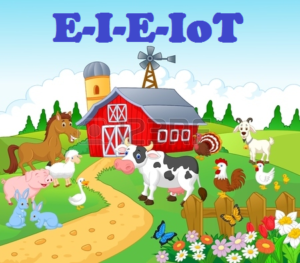Problem to Solve: My company has invested in an IoT platform. For such a vast network of data collection, how can we assure service delivery and performance for the whole platform?
 So what does an old school nursery rhyme have to do with the Internet of Things (IoT)? Not much other than if this nursery rhyme were to come out today, old MacDonald would have some flavor of IoT probably running at the farm.
So what does an old school nursery rhyme have to do with the Internet of Things (IoT)? Not much other than if this nursery rhyme were to come out today, old MacDonald would have some flavor of IoT probably running at the farm.
The new Internet of Things version of Old MacDonald would be more like:
a “device device” here ..
and “cloud cloud” there ..
here an “app”, there a “protocol”
everywhere an “Analytics Analytics”
Old MacDonald had a farm, E-I-E-IoT
So now we are all clear why I did not become a professional nursery rhyme writer. However, when it comes to IoT and the backend service delivery chain involved, I do have some thoughts.
IoT Service Delivery Chain
Think about what an IoT Service Delivery chain actually looks like from the end device collection, all the way through to the back end analytics systems. It includes things like the device, transport of data, data collection, Big Data Analytics, Cloud, and integration with corporate systems.
Device
Information is king, and that is why companies are investing in IoT platforms. The end device “widget” has all kinds of interesting data and metrics about itself. End devices come in all sizes and shapes, things like ATMs, Smart Meters, Google Glass, Medical Devices, Light Bulbs, Batteries, etc. The metrics for these devices will vary based on what the “widget” is, but examples are things like temperature reading, location/GPS, voltage, errors, etc. The data collected from the widget gets turned into business information at the end of the service delivery chain. Some customers are even looking at embedding “applets” (small application footprints) on the end device itself.
Transport
So once you have a device and data, you have to provide some method for getting the data “off of the device”. Transport methodologies vary from RF, cellular, wireless, long haul ethernet to accomplish the harvesting and transport of the collected data. Transport protocols vary from custom developed, HTTP, MDM, Bluetooth, Zigby, MQTT, etc. Many of them are based on IPv6 due to the extreme number of IP addresses involved.
Data Collection
The data from the end device gets transmitted back to a data collection hub. These hubs could be deployed as Cloud options (i.e. Amazon Web Services or Azure IoT Hub), co-location facilities, distributed data centers, or just be back hauled all the way back to the corporate data center. At this layer, the raw data is usually aggregated and processed through to the format that will likely be pushed into a Big Data Analytics solution. Many times this information from the Analytics solution will communicate back to a corporate ERP or CRM system.
Big Data Analytics
There are many types of analytics platforms to help create information from the data. Looking for trends inside the data for usage, failures, metrics, maintenance, population to glean information to make better business decisions is the goal. Creating a competitive advantage into new business markets (i.e.Blue Ocean Strategy https://en.wikipedia.org/wiki/Blue_Ocean_Strategy) from your own collected data is a tremendous opportunity.
The Big IoT Questions to Ask
APM / NPM for IoT